Dartmoor
Explore hidden histories, historic photos, and things you never knew about Dartmoor from the collections and archives of Historic England.
Discover your local listed buildings and places
Introducing some of Dartmoor's most historic sites, included in the National Heritage List for England. Some of these captions have been summarised by AI. Click through for the official List entry. Skip this section and go to place by numbers
Gunpowder factory at Powder Mills, a partially enclosed s…
Dartmoor Forest
The gunpowder factory at Powder Mills is a well-preserved 19th-century site with intact buildings, machinery remnants, and archaeological significance, highlighting Dartmoor's historic...
H M Prison Dartmoor: F and G Wings
Dartmoor Forest
A prison wing of 1809 remodelled before 1885 by Colonel AB McHardy, extended with a six storey prison wing between 1901 and 1904/5 to designs by Alten Beamish, with later alterations.
Castle Drogo
Drewsteignton
Castle Drogo, designed by Sir Edwin Lutyens, was constructed in the early 20th century for Julius Drewe and features formal gardens influenced by Gertrude Jekyll's planting schemes.
Tyrwhitt's Wharf
Buckland Monachorum
A granite horse shed of 1823, built for the Plymouth and Dartmoor Tramway by Sir Thomas Tyrwhitt MP.
Haytor granite tramway
Ilsington
The Haytor Granite Tramway, unique for its use of carved granite instead of iron, provided a crucial link from the Haytor and Holwell Tor quarries.
Blowing house and mill at Gobbet
Dartmoor Forest
Dartmoor's blowing mills smelt black tin using water-driven stamps. Gobbet Tin Mine uniquely integrates all tin processing elements from crazing stones to mould stones.
Spring Head at SX 620 935
Belstone
An spring head structure, possibly with medieval or earlier origins. Built of undressed granite blocks. The spring head is terraced into the hillside.
Wheal Betsy pumping house
Mary Tavy
Wheal Betsy, a 19th century engine house, is a monumentalized landmark on Dartmoor, representing significant technological advancements of the industrial age.
Part of the Dartmeet coaxial field system and other archa…
Holne
Dartmoor's extensive archaeological remains reveal its rich Bronze Age history and later agricultural practices with well-preserved settlements, stone huts, and field systems.
H M Prison Dartmoor: American Prisoner of War Cemetery
Dartmoor Forest
A burial ground laid out in 1866-8 to commemorate the American Prisoners of War who died at Dartmoor Prison during the Anglo-American War of 1812-1815.
Bennett's Cross: a wayside cross on the south side of the…
Chagford
Bennett's Cross, a medieval wayside cross on Dartmoor, serves as a boundary marker and reflects medieval religious customs.
Length of boundary wall and seven stone hut circles formi…
Peter Tavy
Dartmoor, known for its extensive archaeological landscape, holds Bronze Age enclosures like Ger Tor, showing evidence of ancient agricultural and settlement practices beneficial for...
Brisworthy stone circle
Sheepstor
Brisworthy stone circle, partly restored, exemplifies Dartmoor's rich archaeological landscape, connected with prehistoric ceremonies.
Tinworks and other archaeological remains in the Meavy va…
Walkhampton
Dartmoor's tinworks in Meavy Valley illustrate historic tin industry with diverse extraction methods and notable prehistoric remains, providing insights into upland exploitation and ritual...
Church of St Winifred
Manaton
The Church of St Winifred in Manaton features a mix of 15th-century and later architectural elements, including richly carved timber screens and an ornate reredos.
Meldon viaduct
Okehampton Hamlets
Despite modern refurbishments, Meldon Viaduct, a Victorian engineering marvel, is the last surviving high metal viaduct in the country, dramatically positioned in a steep valley.
Stone alignment, hut circle settlement, medieval long hou…
Dartmoor Forest
Dartmoor's historical landscape reveals preserved ceremonial stone alignments, settlements, and agricultural traces spanning 4000 years, offering insights into human exploitation over...
Canonteign Barton
Christow
Canonteign Barton is a historic manor house dating back to the late 16th century, notable for its restoration in the 1970s and connection to the Davy family and Lord Viscount Exmouth.
The Remains of Longstone Manor House, Wind Strew and asso…
Sheepstor
The upstanding and buried remains of a post-medieval, C17 estate house, other associated structures and earthworks above and below the water line to the south, and a wind strew 70m to the...
Prehistoric and historic archaeological landscape at Trow…
Shaugh Prior
The prehistoric and historic landscape at Trowlesworthy Warren on Dartmoor reflects extensive human activity since prehistoric times, featuring settlements, field systems, and industrial...
Five cairns, two stone alignments and three cists, formin…
Dartmoor Forest
Dartmoor's rituals are illustrated by a complex on Lakehead Hill with cairns, stone alignments, and cists, reflecting Bronze Age ceremonial activities.
Partially enclosed stone hut circle settlement known as K…
Dartmoor Forest
Dartmoor's Kraps Ring is a bronze-age stone hut circle settlement providing insights into prehistoric farming and society, reflecting significant archaeological heritage.
Prehistoric and medieval settlements and their field syst…
Manaton
Hound Tor's medieval settlements highlight regional diversity and historical land use in England, with evidence of both medieval and prehistoric occupation.
Foxhole Mine and other tinworks south east of Arms Tor
LCPs of Bridestowe and Sourton
Foxhole Mine and surrounding Dartmoor tinworks reveal diverse historical prospects; the 19th-century site preserves vital insights into past mining and extraction techniques.
Clapper Bridge, Postbridge
Dartmoor Forest
The clapper bridge at Postbridge is the finest in Devon, attracting much visitor attention and serving as a focus on Dartmoor.
H M Prison Dartmoor: French Prisoner of War Cemetery
Dartmoor Forest
A burial ground laid out in 1866-8 to commemorate the French Prisoners of War who died at Dartmoor Prison during the Napoleonic Wars of 1809-1816.
Round cairn and shelter 140m north west of Yes Tor summit
Okehampton Hamlets
Dartmoor's Yes Tor cairn offers archaeological insights into Bronze Age beliefs with its preserved round cairns, showcasing a diversity of prehistoric community structures.
Fingle Bridge
Drewsteignton
A C17 road bridge over the River Teign spanning the civil parish boundaries of Moretonhampstead and Drewsteignton at this popular picturesque location.
Stone circle and cairn 330m south of Little Hound Tor
South Tawton
Dartmoor's stone circles and cairns, including the one 330m south of Little Hound Tor, are significant prehistoric monuments, offering insights into early ceremonial practices.
A stone circle, known as Fernworthy Circle, three stone a…
Dartmoor Forest
Dartmoor’s stone circle and alignments near Sandeman Bridge are nationally important due to their ritual significance, dating from the Late Neolithic period, with well-preserved...
Stall Moor circle and long stone row
Cornwood
The stone alignment on Dartmoor is the longest surviving row, crossing watercourses with a ceremonial purpose. Notable for its well-preserved cairns and historical significance.
Chambered cairn at Ball Gate, Corringdon Ball
South Brent
Dartmoor's chambered cairns provide insights into Middle Neolithic ceremonial practices.
White Tor camp, Cudlipptown Down
Peter Tavy
White Tor camp, Cudlipptown Down record is generated from an old county number scheduling, lacking full modern descriptions.
Horn's Cross
Holne
Horn's Cross is a medieval wayside cross on Dartmoor, marking a historical route between Tavistock and Buckfast Abbeys. It provides insight into medieval routeways and settlement patterns.
Spurrell's Cross
Ugborough
Spurrell's Cross, unique for its spurred limb design, marks a significant intersection on Dartmoor with historical ties to medieval routes and a 15th-century style.
Two concentric stone circles on Langstone Moor
Peter Tavy
Dartmoor's two concentric stone circles are key archaeological sites offering insights into prehistoric ceremonial practices, despite damage and restoration.
Broadun prehistoric enclosed settlement, 780m NNW of Arch…
Dartmoor Forest
The Broadun settlement on Dartmoor is a significant prehistoric site, showcasing well-preserved evidence of early farming practices and diverse social organization, with substantial...
Grimspound, a partially enclosed prehistoric settlement w…
Manaton
Grimspound is a well-preserved prehistoric stone hut circle settlement on Dartmoor, revealing insights into ancient farming and social practices.
Explore more
Search for more listed placesDartmoor through time
This timeline shows the first period of use for buildings and places on the National Heritage List for England, just one of the details recorded for every list entry. Click around to see how Dartmoor changes over time. Skip this section and go to aerial photos
Prehistoric Before AD 43
Prehistory covers a million years of human occupation before the Roman invasion, from hunter-gatherers of several human species, including Neanderthals, to more recent herders and farmers. It was a time of developing technologies and belief systems, involving contact with and migration from Europe, all reflected in the variety of artefact and monument types characteristic of particular prehistoric periods.
Early medieval AD 410 to AD 1066
This period, often associated in England with Anglo-Saxons and Vikings, saw a reduction in urban living from the Roman period and increased migration from northern Europe.
Traces of this period can be found in cemeteries, particularly in artefacts and in some of the very early churches, as this period also saw the growth of Christianity in Britain.
Medieval AD 1066 to AD 1540
This period, sometimes known as the Middle Ages, began with the Norman invasion in AD 1066. It saw a significant rise in military and defensive buildings such as castles and earthworks, as well as religious houses dominating a largely agricultural landscape.
The monarchy and Church dominated the period, which also saw the break with the Roman Catholic Church and the English reformation.
Post medieval AD 1540 to AD 1901
The Post-Medieval period brought seismic changes to life in England, with religious reformation leading to the democratization of worship and the destruction of hundreds of religious houses.
In parallel, there was a huge expansion of scientific study and enlightenment that permanently altered the nation's social structure and landscape. Industrialization and mass production lead to wider global trade, emigration, and immigration.
20th century AD 1901 to AD 2000
The 20th century saw an incredible expansion of England's transport networks, with suburban growth shadowing rapid infrastructural expansion. The establishment of state schools, hospitals, and modern technical colleges, with new architectural styles, radically changed the appearance of towns and cities.
Two catastrophic world wars and the 1918 pandemic also brought unprecedented change, altering England's built environment and social structures forever.
Prehistoric Before AD 43
Prehistory covers a million years of human occupation before the Roman invasion, from hunter-gatherers of several human species, including Neanderthals, to more recent herders and farmers. It was a time of developing technologies and belief systems, involving contact with and migration from Europe, all reflected in the variety of artefact and monument types characteristic of particular prehistoric periods.
Early medieval AD 410 to AD 1066
This period, often associated in England with Anglo-Saxons and Vikings, saw a reduction in urban living from the Roman period and increased migration from northern Europe.
Traces of this period can be found in cemeteries, particularly in artefacts and in some of the very early churches, as this period also saw the growth of Christianity in Britain.
Medieval AD 1066 to AD 1540
This period, sometimes known as the Middle Ages, began with the Norman invasion in AD 1066. It saw a significant rise in military and defensive buildings such as castles and earthworks, as well as religious houses dominating a largely agricultural landscape.
The monarchy and Church dominated the period, which also saw the break with the Roman Catholic Church and the English reformation.
Post medieval AD 1540 to AD 1901
The Post-Medieval period brought seismic changes to life in England, with religious reformation leading to the democratization of worship and the destruction of hundreds of religious houses.
In parallel, there was a huge expansion of scientific study and enlightenment that permanently altered the nation's social structure and landscape. Industrialization and mass production lead to wider global trade, emigration, and immigration.
20th century AD 1901 to AD 2000
The 20th century saw an incredible expansion of England's transport networks, with suburban growth shadowing rapid infrastructural expansion. The establishment of state schools, hospitals, and modern technical colleges, with new architectural styles, radically changed the appearance of towns and cities.
Two catastrophic world wars and the 1918 pandemic also brought unprecedented change, altering England's built environment and social structures forever.
Aerial photos of Dartmoor
Aerial photography helps reveal secrets of England's changing landscapes that are impossible to see from the ground. Skip this section and go to archive images
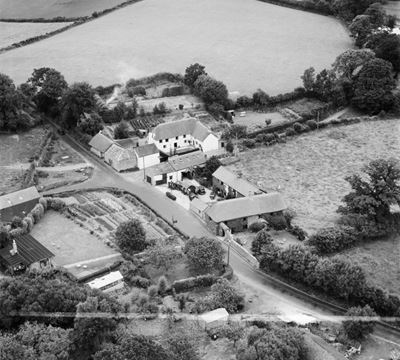
Easton
Easton Court Hotel, Easton, 1950
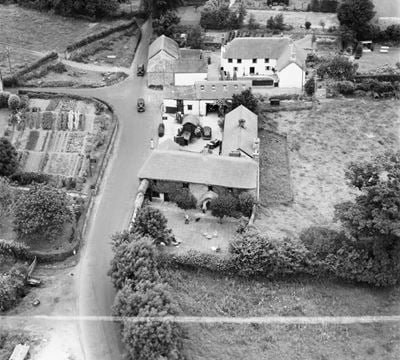
Easton
Easton Court Hotel, Easton, 1950

Princetown
Dartmoor Prison, Princetown, 1930

Princetown
HM Prison Dartmoor, Princetown, 1953
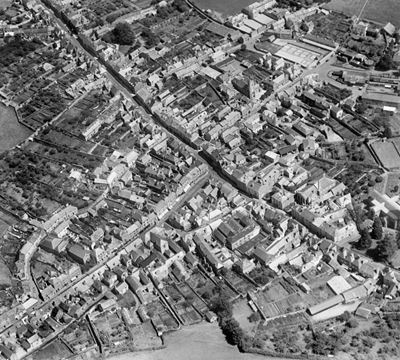
Ashburton
The Bull Ring and environs, Ashburton, 1930

Ashburton
East Street and St Andrew's Church, Ashburton, 1932

Buckfast
St Mary's Abbey and the Lower Buckfast Woollen Mill, Buckfast, 1930
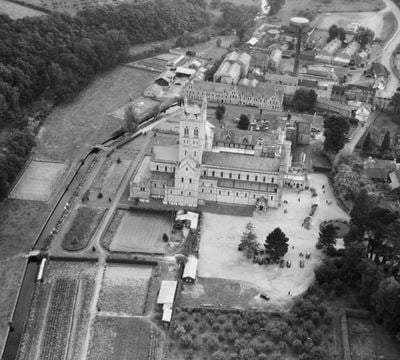
Buckfast
St Mary's Abbey, Buckfast, 1947
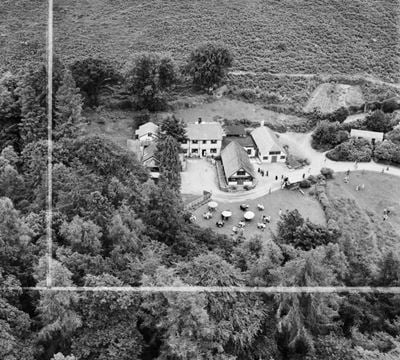
Dartmeet
Badger's Holt, Dartmeet, 1950

Dartmeet
Badger's Holt, Dartmeet Bridge and the surrounding area, Dartmeet, 1950
Dartmoor in the Historic England Archive
The Historic England Archive cares for over 15 million images, dating from the 1850s to the present day. Discover stunning images of Dartmoor's past. Skip this section and go to stories about heritage
Charles George Harper Collection
Teignbridge, Devon
Date created: 1892 - 1933
Looking out of the south porch of St James the Apostle's Church towards the churchyard, showing the ledger stone used as a paving slab which...
Eileen ‘Dusty’ Deste Collection
Dartmeet, Teignbridge, Devon
Date created: 1967
Dartmeet Bridge crossing the East Dart River
Eric de Mare
West Devon, Devon
Date created: 1945 - 1980
General perspective view of the Postbridge in Dartmoor forest. It is made of granite slabs and piers and crosses the East Dart.
John Gay Collection: Rural Life
Devon
Date created: 1955 - 1965
A view of a stream running through a lightly wooded area, with a fern growing on a bank in the foreground.
John Gay Collection: Counties
Sheepstor, West Devon, Devon
Date created: 1955 - 1965
A dog walks on the pedestal of the late medieval Village Cross situated in the middle of Sheepstor in West Devon.
London, Midland and Scottish Railway Company
Lydford Gorge, West Devon, Devon
Date created: 10 Jul 1911 - 14 Jul 1911
A view of Lydford Gorge
Alfred Newton and Sons
Buckland-In-The-Moor, Teignbridge, Devon
Date created: 25 May 1904
GENERAL VIEW SHOWING COTTAGES HIDDEN BEHIND TREES
Nigel Temple Collection of Postcards of Parks and Gardens
Dart Bridge, Teignbridge, Devon
Date created: 1939 - 1950
EXTERIOR VIEW FROM THE TEA GARDEN
Margaret Tomlinson Collection
Teignbridge, Devon
Date created: Aug 1944 - Dec 1944
A view looking east from the tower of Holy Trinity Church towards the chapel ruins at the far end of the graveyard
Eileen ‘Dusty’ Deste Collection
Teignbridge, Devon
Date created: 1967
Ouldsbroom Cross at the junction of the B3357 and the lane to Ponsworthy
Nigel Temple Collection of Postcards of Parks and Gardens
Teignbridge, Devon
Date created: 1930 - 1960
EXTERIOR VIEW FROM THE TEA GARDEN
Margaret Tomlinson Collection
Teignbridge, Devon
Date created: Aug 1944 - Aug 1945
A view from Dart Bridge showing Dartbridge Cottage Toll House and the A384 Totnes Road
Stories about heritage in your local area
Historic England publishes news, blogs, research, videos, and podcasts celebrating England's rich heritage. Discover the stories we have about Dartmoor. Skip this section and go to education
What Is the Oldest Building in England?
From the oldest church to archaeological remains, here are the contenders for England's oldest building.
Secret Worlds Hidden Beneath Surface Structures
Mentions Octagonal Ventilation Shaft About 140 Metres South of Canonteign Barton
Unusual and often puzzling surface structures can be found in our cities, towns and countryside.
Sherlock Holmes and the Case of the Listed Building
Mentions Prehistoric and medieval settlements and their field systems at Hound Tor
These are the listed buildings cunningly woven into the world of TV series ‘Sherlock’
Emmets Post
Mentions Dartmoor
An archaeological project part-funded by Historic England revealed intriguing construction details at a Bronze Age barrow on the edge of Dartmoor.
Introduction to Issue 15
Mentions Dartmoor
Introducing highlights of research from the South East and South West regions and their adjacent waters, along with a national scope archive project.
Archaeology From a Distance
Mentions Dartmoor
Aerial archaeology as social distancing: find out how the Historic England aerial survey team has adapted to restrictions during the Covid-19 pandemic
Research Reports Roundup August 2023
Mentions Dartmoor
A roundup of recent research reports added to our database in June 2023 to August 2023, displayed by heritage themes.
Heritage at Risk, Volunteering and Wellbeing
Mentions Dartmoor
New research illuminating the relationship between volunteering on Heritage at Risk projects and wellbeing.
Progress for Peatlands
Mentions Dartmoor
The historic and natural importance of peatlands with respect to tackling climate change.
Pilot Scheme Success in Restoring Historic Barns
Mentions Dartmoor
Bringing life back to traditional agricultural buildings within the participating National Park boundaries.
Dartmoor's social history through photos
Over 10,000 images from the Historic England Archive have been specially selected and re-captioned for teachers, students, and anyone who wants to learn more about their local area. Skip this section and go to grant-aided places
St Michael's Cottages, Ilsington, Devon
Period: Tudor (1485 - 1602)
This row of 3 cottages dates from the early 16th century and was formerly the church house.
St Michael's Cottages, Ilsington, Devon
Row of 4 cottages, Chapel Street, Buckfastleigh, Devon
Period: Stuart (1603 - 1713)
This row of 4 cottages has a tenter loft, for drying cloth, on the upper storey. The cottages date from the late 17th or early 18th century.
Row of 4 cottages, Chapel Street, Buckfastleigh, Devon
Powder Mills, Dartmoor Forest, Devon
Period: Victorian (1837 - 1901)
The ruins of a gunpowder mill. The mill was established in 1844 by a Plymouth alderman, George Frean.
Powder Mills, Dartmoor Forest, Devon
Okehampton Castle, Okehampton, Devon
Period: Medieval (Middle Ages) (1066 - 1484)
The earliest structure is the 11th century keep standing on its motte (mound).
Okehampton Castle, Okehampton, Devon
Moretonhampstead Almshouses, Moretonhampstead, Devon
Period: Medieval (Middle Ages) (1066 - 1484)
These almshouses are believed to have been built near a medieval hospital of 1451 and may well be a remodelling of the building itself.
Moretonhampstead Almshouses, Moretonhampstead, Devon
Mill Street, Chagford, Devon
Period: Victorian (1837 - 1901)
General view looking north-west along Mill Street, from the junction with North Street. The photograph was taken by a Miss Ormerod.
Mill Street, Chagford, Devon
Meldon Viaduct, Meldon, Okehampton Hamlets, Devon
Period: Victorian (1837 - 1901)
A train crossing the Meldon viaduct seen from ground level.
Higher Mill, Higher Mill Lane, Buckfastleigh, Devon
Period: Georgian (1714 - 1836)
There was a mill on this site by at least 1730. It was described as a tucking mill by 1760.
Higher Mill, Higher Mill Lane, Buckfastleigh, Devon
Discover more
Ready for more local stories? Take a look at these other places nearby


